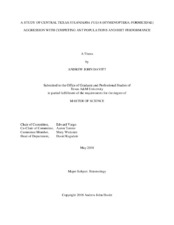| dc.description.abstract | Nylanderia fulva, native to South America, is an ecologically dominant invasive ant in the U.S. that has spread to central Texas. This species is able to quickly form large colonies and displace established ant populations in its invasive range, reducing local ant biodiversity. Because populations of N. fulva have only recently begun to expand rapidly there is much we do not know about this ecologically and economically important species. The studies presented here were aimed to better understand N. fulva’s remarkable displacement of local ant populations, as well as provide an effective method of rearing N. fulva long term, so that important research may be carried out expeditiously.
In order to help elucidate how N. fulva is able to displace local ant populations, aggression assays were carried out between N. fulva and common ant species present in central Texas. These results indicate that N. fulva is highly aggressive to both Solenopsis invicta and larger bodied ant species. This matches field observations of ant displacement due to N. fulva invasion, indicating that N. fulva may displace local ant species through direct confrontation.
N. fulva populations become scarce during the winter, and do not begin to resurge until late spring, making collections and research difficult during this time. It is also difficult to keep N. fulva colonies in a lab setting. In order to ameliorate this, a diet performance study was performed so that stock colonies of N. fulva may be kept over a long period of time, so that research may continue on this invasive ant throughout the year. Of all diets we tested, our results show a diet of the beet armyworm Spodoptera exigua augmented with an artificial insect diet resulted in the highest level of brood production and colony growth over the course of the study. | en |


